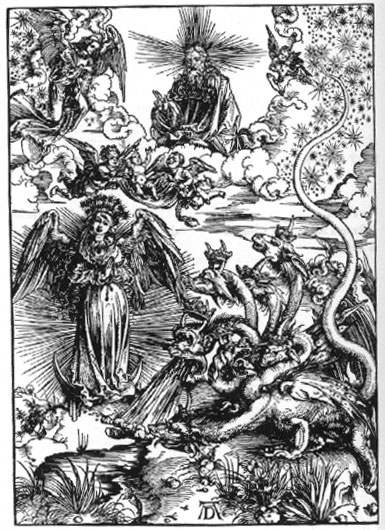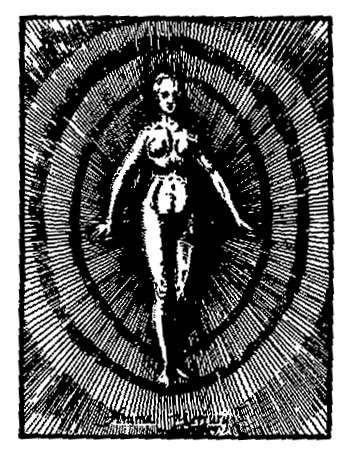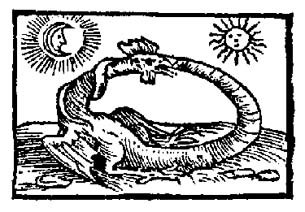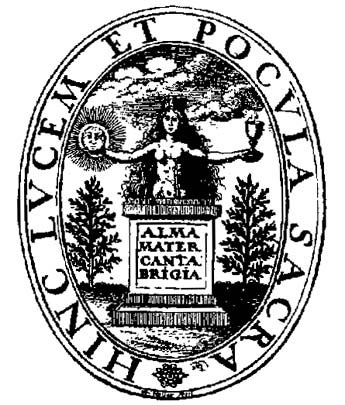|
A Case Study in the Earliest Manifestations of Christian Esotericism Laura Hobgood-Oster Southwestern University It is I who am the part of my mother;
Esoteric tendencies and movements appear consistently within Christianity. At their foundation lies Gnosticism, in early Christianity the sect of "knowing ones."[2] Gnosticism, in its many forms, is based on, though not limited to, the acquiring of gnosis – or "saving knowledge." Indeed a Greek lexicon would distinguish the two terms central to this article – gnosis and esoterikos, but their meanings could be closely connected.[3] Arguably, Gnosticism is the earliest and most affecting of all manifestations of Christian esotericism. From Meister Eckhart to Jacob Boehme to Emmanuel Swedenborg to a plethora of related esoteric strands that developed in American Christianity—even in the Shakers with their prophet |
|
||
|
|
||
|
|
||
|
Mother Ann Lee—parallels to Gnostic concepts, structures and alternate mythologies can be found.[4]
Modern scholars apply the term Gnosticism to a variety of religious movements which developed in the Mediterranean world during the same historical period in which Christianity formed. "Gnosticisms" provide examples of the religious syncretism occurring throughout the Roman occupied territories in the Hellenistic ethos of the first few centuries of the Common Era. For centuries, insight into Gnosticism's early Christian form had been gathered primarily from influential defenders of developing and consolidating orthodoxy, such as Clement, Origen and Irenaeus. These definers of orthodox Christianity condemned what they labeled as the Gnostic heresy. Indeed, such defense against Gnosticism served as a primary impetus to their momentous theological constructs. In many ways, Christianity's orthodox theological system and doctrine formed in response to Gnostic heresy. Obviously, then, these sources have provided a closely circumscribed lens through which to view Christian Gnosticism for almost two thousand years. In 1945 an amazingly preserved set of Gnostic works was discovered at Nag Hammadi in Egypt. This find enables modern scholars to glance through an insider "knower's lens" at this incredibly significant aspect of earliest Christianity. The collection of thirteen papyrus codices were composed in Coptic, though most likely translated from Greek, between the third and fifth centuries C.E. This invaluable discovery provides an entirely different and fertile glimpse into Christian Gnosticism, particularly into its complex mythological system, from its own perspective rather than that of orthodox, condemning outsiders. Of course, a religious system which is esoteric in its very essence could never be comprehended through the perspective of outsiders or "unknowers," the only perspective available prior to the discovery of the Nag Hammadi library. For this very reason – the esoteric nature of Gnosticism and its wide-ranging influence – the weight of the discovery of these documents compounds. |
||
|
|
||
|
|
||
|
The extremely complex mythological system can be found within the Nag Hammadi texts. It provides the map of the maze through which an understanding of the secret truths of salvation conveyed to and among early Gnostics. Indeed the mythic essence, which remains particularly hidden to the minds of those outside of Christian Gnosticism, serves as one of the most fascinating aspects of Gnosticism. As a religious system it does not lend itself to the constructs of systematic theology – a veritable cornerstone of most intense Christian self-articulation. Rather, Gnosticism only becomes comprehensible through the avenue of myth. Processes of formation into the mythological world of Gnosticism unlocked its closed systems of communication and provided a new understanding of self and salvation. Because of its intensive and complex layers an explication of Gnostic mythology often requires that one select a particular aspect of the system rather than attempt to address its entirety. This study, then, will focus on a selected, central theme in Gnostic mythology – the Creation – and one pivotal figure within this re-told story of human origins – Eve.
It has been claimed, and I agree, that "the wild profusion of gnostic myths can be traced to a single scriptural source: Genesis 1-3."[5] Stories of Adam and Eve fascinated Gnostic Christians, probably as a result of the myriad allegorical interpretations apparent in this pivotal and foundational myth. Such myths of origin explain more completely than any other mythological elements why creation is in its current, and in Gnosticism, dreadfully fallen and evil, state: It is now a matter of understanding, intuiting, and reliving the origi- nal drama, the initial situation that provoked the rise, the establish ment and the triumph of evil, an evil that has now acquired an ontological toughness and substance. . . Myth thus acquires the function of salvation. It describes the way of salvation, reminding the Gnostic of his [sic] true origins and showing him [sic] how to escape from the cosmos. But above all, like all myth, that of the Gnostics is essentially a story of origins; there lies the key of all that one thinks one possesses.[6] |
||
|
|
|||
|
|
|||
|
In order to examine Eve, one particular Nag Hammadi text in which she plays a prominent role can serve as the tool – On the Origin of the World (hereinafter OW). Many other texts from the Nag Hammadi library include Eve as a central figure – for example, The Hypostasis of the Archons, and The Apocalypse of Adam. I claim that insight into her representation provides a glimpse into the entire hidden knowledge requisite for salvation within Christian strands of Gnosticism. In other words, understanding the Eve of Gnostic Christianity as contrasted with the Eve of most orthodox manifestations of Christianity illuminates the fundamental nature of this powerful strand of esotericism. Eve as Revealer of Gnosis After the day of rest Sophia sent her daughter Zoe, being called Eve, as an instructor in order that she might make Adam, who had no soul, arise so that those whom he should engender might become containers of light. (115:31-35)[7] In a quest to understand its own soteriology, early Christianity turned to the figure of Eve, demonizing her with unprecedented force. Christ's role in redemption became explicable only in its relationship to the Fall as portrayed in Genesis. Eve, along with her sinister partner the serpent, became the antagonist who, through her wiles, led the paradisical Adam away from God. As this understanding of Eve's inferiority and propensity for sin remains embedded in late twentieth-century culture, a few examples of it as a doctrine during the time period addressed should suffice to provide contrast with the Eve of Gnosticism. Of course, one must begin with the appearance of Eve as recounted in the second creation account, which tends to be the more prominently retold of the two, possibly because of its intrinsic male/female hierarchical structure.[8] |
|
||
|
|
||
|
|
||
|
Presented in Genesis, Christians learned from the story that the creation of woman varied significantly from that of man:
So the Lord God caused a deep sleep to fall upon the man, and he slept; then he took one of his ribs and closed up its place with flesh. And the rib that the Lord God had taken from the male he made into a woman and brought her to the man. (Genesis 2:21-22)[9] The derivative nature of Eve posits an ontological distinction and inferiority in her from the beginning. Thus Paul, the earliest constructive Christian theologian, can claim: For a man ought not to have his head veiled, since he is the image and reflection of God; but woman is the reflection of man. Indeed man was not made from woman, but woman from man. Neither was man created for the sake of woman, but woman for the sake of man. (I Corinthians 11:8-9)[10] Almost as an afterthought, upon the failure of all other creatures to satisfy the needs of the male human being, God created the female with the express purpose of being Adam's companion. According to the rest of the story, this creation from Adam's rib may not have been wise, rather it led to expulsion from Paradise. Ambrose, the bishop of Milan in the late fourth century, delves into her extensively in his work Paradise. Eve, as "the first to be deceived," was therefore "responsible for deceiving man," thus Adam "fell by his wife's fault, and not because of his own."[11] At the beginning of the fifth century, Augustine of Hippo clearly stated his understanding of the inferiority of Eve: Was it because the man would not have been able to believe [the transparent lies of the serpent] that the woman was employed [by the serpent] on the supposition that she had limited understanding, and also perhaps that she was living according to the spirit of the flesh and not according to the spirit of the mind? [12] |
||
|
|
||
|
|
||
|
Eve symbolizes weakness, sensuality, temptation and disgrace. Second in the order of creation, her purpose was to serve Adam; lacking in wisdom her actions in the garden led to the fall of all humankind. Eve destroyed humanity's hope for paradise on earth and, without the advent of Christ, for hope in eternity. Augustine and Ambrose interpreted the significance of Eve in the same general time frame as the Gnostic development of mythologies in which Eve played a central role. However, these two early orthodox Christian theologians, through their explications of the "first" woman, contributed enormously to the construction of both "Eve" and "womanhood" for all subsequent generations of Christians. Indeed, Eve still serves to connect "woman" to that which is secondary and evil, derivative and weak, as that which led to the "fall" of all humanity. Though many Christians in the late twentieth century would understand such a literal construction to be inadequate and misplaced, biblical literalists, whose impact cannot be underestimated in modern Christianity, would continue to blame Eve, and therefore all women, for humankind's expulsion from Paradise. Such beliefs remain embedded in ecclesiastical systems and doctrines worldwide. But this is not the Eve we meet in Gnostic Christian texts. Here, her descriptions are those of a guide, instructor, and even a savior figure. Her essence and actions serve to provide gnosis and illumination for humanity. She is an "other" Eve. To grasp this overwhelming difference, one must first hear at least a portion of the Gnostic myth as told in OW. The orthodox "Genesis creation myth" and the role of Eve take on an entirely different form when related by the Gnostic community who heard and retold their understanding of creation in OW. |
||
|
|
|||
|
|
|||
|
On the Origin of the World: Selected Portions and Exegesis Included in this brief exposition are the passages from OW which prove the most pertinent for understanding the Eve of Gnostic Christianity. Here the reader is exposed to what the Gnostics knew that the orthodox Christians did not. And when they had finished Adam, he abandoned him as an inanimate vessel lest the true man enter his modelled form and become its lord. For this reason he left his modelled form forty days without a soul on the fortieth day Sophia Zoe sent her breath into Adam, who had no soul. He began to move upon the ground. And he could not stand up. (115:3-15) The seven rulers or authorities - to put it too simply, these rulers - are rather low-level supernatural figures connected to the physical creation, made the body of Adam. However, they determined that Adam, if given a soul, could be more powerful than they; therefore he was created as an inanimate being. Sophia Zoe, a figure seemingly superior to the seven rulers in Gnostic cosmology, gave Adam life through her breath. This ontologically transforming endowment shocked and angered the rulers. But the giving of life did not empower or liberate Adam fully: he was still relegated to crawling on the ground.[13] His weakness appeased the seven rulers who then took him and placed him in Paradise, then retreated to their heavens. At this point in the story, Eve enters: When Eve saw her male counterpart prostrate she had pity upon him, and she said, "Adam! Become alive! Arise upon the earth!" |
|
||
|
|
||
|
|
||
|
Immediately her word became accomplished fact. For Adam, having arisen, suddenly opened his eyes. When he saw her he said, "You shall be called 'Mother of the Living'. For it is you who have given me life." (116:1-7)[14]
Obviously, roles reverse in the Gnostic version of the creation story, though they will address the lack of knowledge of this reversal related through the other telling in Genesis. Rather than Eve's life being created from Adam's rib, Adam's soul is endowed by Eve – she becomes the active giver of life, rather than the passive receiver from Adam. Eve's role continues to develop in OW : Then the authorities were informed that their modelled form was alive and had arisen, and they were greatly troubled. They sent seven archangels to see what had happened. They came to Adam. When they saw Eve talking to him they said to one another, "What sort of thing is this luminous woman? For she resembles that likeness which appeared to us in the light. Now come, let us lay hold of her and cast our seed into her, so that when she becomes soiled she may not be able to ascend into her light. Rather, those whom she bears will be under our charge. But let us not tell Adam, for he is not one of us. Rather let us bring a deep sleep over him. And let us instruct him in his sleep to the effect that she came from his rib, in order that his wife may obey, and he may lord over her." Then Eve, being a force, laughed at their decision. She put mist into their eyes and secretly left her likeness with Adam. She entered the tree of acquaintance and remained there. And they pursued her, and she revealed to them that she had gone into the tree and become a tree. Then, entering a great state of fear, the blind creatures fled. (116:8-34) In their plan to destroy Eve, the authorities create a lie – that Eve |
||
|
|
||
|
|
||
|
came from Adam's rib. This fabrication of modeling from Adam's rib becomes the crux around which the orthodox interpretation of Eve, an interpretation which lacks requisite knowledge for salvation, revolves. One need only peruse the dogmatic systems of particular twentieth century Christian groups to be reminded of the power of the image in justifying the subordination of women.
Of course, the rulers are "very glad" that they - the "female creature," along with Adam and their children - were "erring ignorantly like beasts." (118:9-10) Of course the true Eve remained hidden in the tree. But the story of Eve continues to unfold. The "likeness" of Eve who was with Adam, as opposed to the "true Eve" in the tree, also enacts a central role in salvation. As in the Genesis story, she decides to eat from the tree of gnosis and to share its enlightenment with Adam: Then their intellect became open. For when they had eaten, the light of acquaintance had shone upon them When they saw that the ones who had modelled them had the form of beasts they loathed them: they were very aware From that day, the authorities knew that truly there was something mightier than they. [119:10-20; 120:13-15]
Obviously, this choice would be lauded by Gnostics, for whom attaining this once hidden knowledge holds the key to their salvation. Two Eves, both of whom contribute uniquely and necessarily to gnosis, hold sway in the Gnostic creation myth. Eve is the secret key to salvation, a key hidden from orthodox Christians. Implications What, then, are the implications from an exegesis of this alternate, Gnostic creation mythology? One can only speculate as to the impact of a reconstructed Eve. Interpreted as the cause of the fall of |
||
|
|
||
|
|
||
|
humanity from a state of perfection, as the temptress, as the impetus for the loss of paradise, as evil incarnate, Eve serves as the defining figure for all women in Christian history, replaced only in part by another oppressive female figure, the Virgin Mary. The Gnostic Eve, on the other hand, exists as the primary and first instructor, she appears as luminous, and gives the gift of light to humanity. No longer an embodied creature to be loathed and feared, woman carries the light of salvation within herself.
The implications of this text, as opposed to the one in Genesis, are revolutionary in terms of the traditional relationship which developed with Christian, patriarchal societies. One more stark example should suffice. In his Lectures on Genesis, Martin Luther restated the orthodox interpretation of Eve: Although Eve was a most extraordinary creature, similar to Adam so far as the image of God is concerned, that is, in justice, wisdom, and happinesss, she was nevertheless a woman. For as the sun is more excellent than the moon (although the moon, too, is a very excellent body), so the woman, although she was a most beautiful work of God, nevertheless was not the equal of the male in glory and prestige. Furthermore, Eve bore "the weak part of human nature;" therefore the "rule remains with the husband, and the wife is compelled to obey him by God's command."[15] Luther's words concerning Eve were written more than a thousand years after those of Augustine, quoted above. Yet, the interpretation of Eve remained veritably unchanged. Obviously, in orthodox Christianity, Eve bears an entirely different meaning than she does in Gnostic Christianity. Some scholars argue that little significance can be found in this revaluation: |
||
|
|
|||
|
|
|||
|
It is easy to see how someone interested in "knowledge" might have considered the eating of the fruit of the tree of knowledge a step in the right direction rather than a mistake it is only natural that favorable attention instead of censure might be directed toward that person who, according to the inherited tradition, took the leading role in eating of the fruit of gnosis. That this person is female is a given in the tradition but not necessarily something that was of interest to all gnostic interpreters, any more than was Adam's maleness.[16]
But such an argument denies the power of the myth. And it is through an understanding of the myth that the knowledge requisite for salvation comes to Christian Gnostics. Without a systematic theology to explain the story, the construction of the story itself remains focal. Certainly, Eve as the initiator of acquiring knowledge or acquaintance would be seen as the foremost ancestor of those who had received gnosis. More importantly, however, is the understanding of her pivotal role as salvific rather than as horrific and evil. The outcomes of this alternate interpretation may have included an entirely different structure of the male/female duality and hierarchy in Western culture. Of course, such a statement begs to be critiqued as entirely speculative, as it is. But the power of the orthodox Christian interpretation of Eve changed the lives of most women over a two-thousand year period in the West, and continues to do so throughout the world as Christianity permeates myriad cultures. Could not the hidden knowledge of the Gnostics include an anthropology so revolutionary – not androcentric but egalitarian? In acquiring such knowledge of transformation in human relationship, Gnosticism may have believed that one could move forward on the path toward enlightenment. Salvation remains hidden from unknowing eyes, and those Christians without knowledge, those who did not know the Gnostic creation story, remained and remain in darkness. In a religious metaphorical and mythological system which is solely male is terms |
|
||
|
|
||
|
|
||
|
of its images of the divine and of its established, male-centered anthropology, a "symbolic hierarchy is set up: God-male-female. Women no longer stand in direct relation to God; they are connected to God secondarily, through the male."[17] The Gnostic Eve, however, is not only luminous, but she is a force equated with the tree of acquaintance, with salvific knowledge itself.
1 All citations from On the Origin of the World are from The Nag Hammadi Library, ed. James Robinson, rev. ed. (San Francisco: Harper, 1988). For ease of reference, they will be cited in the body of the article by original text page and line number, as indicated in Robinson's edition. 2 Hans Jonas, The Gnostic Religion (Boston: Beacon, 1991, 2nd edition) 32. 3Esoterikos can be defined as private or secret, especially as understood by a select few who have special knowledge. 4 For a concise overview of Gnosticism see: www.gnostic.org. 5 Elaine Pagels, "Adam, Eve and the Serpent in Genesis 1-3," in Images of the Feminine in Gnosticism, 412. Other Nag Hammadi texts which include the Genesis creation account(s) are: Gospel of Philip, Exegesis on the Soul, Hypostasis of the Archon, Thunder: Perfect Mind, Apocryphon of John and Apocalypse of Adam. 6 Giovanni Filoramo, A History of Gnosticism, 52-53. 7 All citations from OW are taken from The Nag Hammadi Library, ed. James Robinson, rev. ed. (San Francisco: Harper, 1988). They will be cited in the body of the article by original text page and line number, as indicated in Robinson's edition. 8 The reader is reminded that in the first chapter of Genesis humankind is created "male and female" simultaneously by God. 9 All biblical quotations are taken from The New Revised Standard |
||
|
|
||
|
|
||
|
Version, issued by the National Council of the Churches of Christ, 1989.
10 In fairness to Paul, it should be noted that he continues this dialogue by stating that "just as woman came from man, so man comes through woman." 11 Ambrose, Paradise, 4.24, 10.48. For a collection of writings from Ambrose and other "Early Church Fathers" see: http://ccel.wheaton.edu/fathers2/ . 12 Augustine, The Literal Meaning of Genesis, 11.37. To view both Latin and English versions of Augustine's works see: http://ccat.sas.upenn.edu/jod/augustine.html . 13 The analogy of movement between Adam and the serpent is intriguing here. 14 The etymology of the Hebrew word "Eve" has been interpreted in various ways, including "first woman," "mothers of all living things" or, even "serpent" – thus associating her with the concept that all life originated in a primeval serpent. 15 Martin Luther, Lectures on Genesis, volume I of Luther's Works, 69, 151, 202. Quotations taken from Margaret Miles, Carnal Knowing (New York: Vintage, 1991) 107-112. Some of the works of Luther can be found on the Wittenberg Project's site: http://www.iclnet.org/pub/resources/text/wittenberg/wittenberg-luther.html . 16 Michael Williams, "Variety in Gnostic Perspectives on Gender," Images of the Feminine in Gnosticism, (Philadelphia: Fortress, 1988) 8. 17 Jerry D. Meyer, "Profane and Sacred: Religious Imagery and Prophetic Expression in Postmodern Art." Journal of the American Academy of Religion LXV/1, 42. |
||



